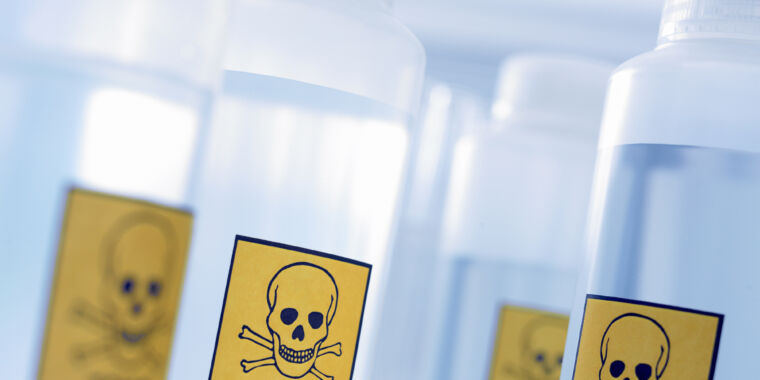
Neil Bradbury is a physiology professor whose first book, A Taste for Poison, uses tales of poisons and poisoners as a means to explain physiological processes by describing how each poison disrupts them. The grisly episodes are like the proverbial spoonful of sugar that makes the medicine go down; Bradbury seems to think that people will only read about human physiology if they are first treated to stories demonstrating that science isn’t boring, that it can actually be dangerous and racy. He might be right.
Each chapter focuses on one fatal molecule and the murderers who used it and then goes on to explain how it kills. So we learn about how electrical signals are propagated down the length of nerve cells and then transmitted across synapses by neurotransmitters. That shows up in the chapter on atropine, the toxin in deadly nightshade that blocks the neurotransmitter acetylcholine, and again in the chapter on strychnine, a popular rat killer that blocks the neurotransmitter glycine. We learn about aerobic respiration in the chapter on cyanide, which prevents the mitochondria in our cells from using oxygen to generate energy. And we read about protein synthesis in the chapter about ricin, which destroys ribosomes, the complexes responsible for protein assembly in every cell.
A better alternative?
As a pedagogical tool to teach physiology, the book is cute, but that’s about all it is. Deborah Blum’s The Poisoner’s Handbook is about the birth of toxicology and forensic medicine; it covers similar ground, but it’s much more engaging.
Blum is also a Pulitzer Prize-winning writer, whereas Dr. Bradbury is not. There are some pretty clunky sentences in here. In describing one victim’s request to her (murderous) husband that he come get her in a while to watch TV, he writes, “As it turned out, Elizabeth would never watch television again.” Ugh.
In relating another poisoner’s interview after murdering his wife (and sickening eight other people), Bradbury writes, “He begged the culprit to come forward and surrender to the police as soon as possible—all the while knowing that he himself was the man the police were looking for.” And when conveying how radioactive polonium-210 destroys DNA, he writes, “The alpha particles indiscriminately destroy the liver cells, like Vandals sacking Rome.”
But Bradbury has a sense of humor, so we also get a couple of sentences that are not necessarily gems but can definitely induce a smile. In introducing a victim of aconite poisoning, Bradbury notes, “Spending more than a second in thought, one would realize that going by the nickname ‘Lucky’ was just tempting fate.”
What’s so great?
The quote Bradbury chose as an epigraph begins, “As a rule, women are the great poisoners.” That’s a weird statement, given that his first three stories are about men poisoning their wives. The fourth is about a man poisoning his lover, for whom he had divorced his wife. Then there’s a short interlude about the Russian government tracking down and poisoning a turncoat before we move on to the Lambeth poisoner, whose victims of choice were prostitutes. So it’s not clear how Bradbury defines “great,” but it doesn’t seem to be based on frequency.
The Lambeth poisoner only went after prostitutes after poisoning his pregnant wife. Actually, a number of the victims described here were pregnant; the men apparently figured that poisoning them was preferable to having to deal with a baby. In this sense, the poisoners reflect society at large, as the biggest risk that pregnant women face in the US is homicidal partners.
Hopefully, people who read this book will take Bradbury’s author’s note accompanying the appendix (entitled “Pick Your Poison”) to heart; it states, “The following information is purely for educational purposes only and is not intended to give the advantages or disadvantages for the use of any particular poison in the commission of murder.”








